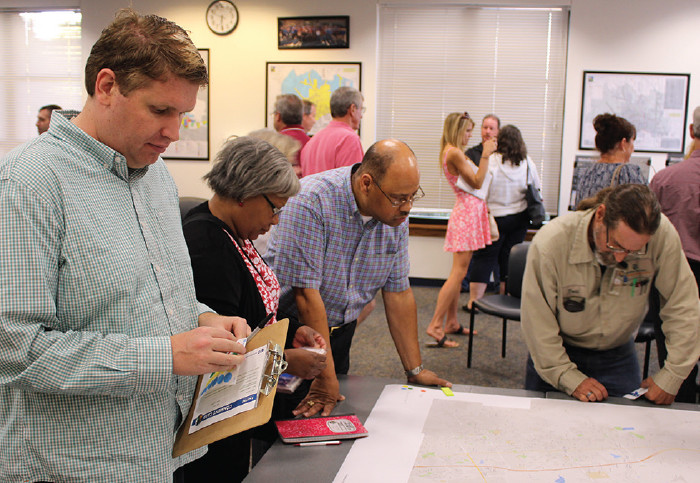New train cars and buses for Leander commuters could arrive at the Capital Metro Leander Station Park & Ride by late 2017 to early 2018, and residents heard a preview of transit plans during an Aug. 19 open house.
Leander is the northernmost stop for Capital Metro’s bus and train services. Leander has a pivotal role in Capital Metro’s future, including in development around its train station, said Todd Hemingson, Capital Metro vice president of strategic planning and development.
Hemingson said Capital Metro hopes to add services by 2018 in anticipation of growth beside the railroad.
New neighborhoods in north Leander, such as Oak Creek and Bryson, are expected to draw more residents, and a Leander campus for Austin Community College is planned to open in summer 2018. City leaders also hope to promote projects downtown, known as Old Town Leander, which would be part of a larger plan to develop a mix of residences and retail in the city’s transit-oriented development, or TOD, district, which includes the rail line Leander Station.
“Ridership will grow or continue to grow,” Hemingson said, referring to trains between Leander and Austin. “We’ve seen ridership quadruple since we opened five years [ago].”
Capital Metro has operated in Leander since 1985, when buses ran between Austin and the parking lot of Leander Church of Christ on Crystal Falls Parkway. In 2009, Capital Metro moved operations to the new Leander Station as part of the MetroRail line.
Leander funds Capital Metro access through the city’s 2 cent sales tax. For every dollar of merchandise sold in the city, 1 cent goes to the city’s budget and 1 cent goes to Capital Metro.
Mayor Chris Fielder said Capital Metro’s services will continue to be beneficial to the city’s growth.
“Leander is the only city in Williamson County that has a train station,” Fielder said.
Train access draws commuters from nearby cities, such as Liberty Hill, or farther cities, such as Jonestown, and commuters driving through Leander shop at local businesses, Fielder said.
Leander resident Paul Fawver said he takes the train to his Austin office.
“If I had to drive my truck downtown it would have cost me $360 a month,” for tolls and gas, he said.
However, Fawver said the train cars are not suitable for moving large amounts of people and suggested Capital Metro add larger cars.
Some residents doubt if Capital Metro services benefit the city, resident Kevin Autin said.
Autin said bus and train services misdirect funds from sales taxes that could better be spent in other ways, such as providing direct incentives for employers to move to Leander.
“You’ve got Cedar Park 8 miles down the road—they’re right on Austin city limits; they said no [to Capital Metro funding], so they’re getting all our traction,” Autin said. “They’ve got their money that they can use for incentives to bring people in.”
Cedar Park’s 2 cent sales tax is split between city revenue and two boards whose members are tasked with promoting economic development, including incentives for companies.
During the meeting in Leander, City Manager Kent Cagle said Leander leaders’ vision for a TOD district that includes trains and buses may take longer to develop, but it will benefit the city in the long term.
“We’re in the running for several big projects right now because of the train station,” Cagle said.

Attendees at an Aug. 19 meeting in Leander asked Capital Metro staffers questions about bus and train benefits in Leander and used maps to indicate their home locations and transportation needs.[/caption]
 Attendees at an Aug. 19 meeting in Leander asked Capital Metro staffers questions about bus and train benefits in Leander and used maps to indicate their home locations and transportation needs.[/caption]
Attendees at an Aug. 19 meeting in Leander asked Capital Metro staffers questions about bus and train benefits in Leander and used maps to indicate their home locations and transportation needs.[/caption]




